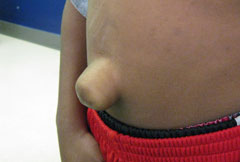Umbilical Hernia
What is an umbilical hernia?
A hernia is a defect or a hole in the muscle layer of the abdominal wall. In an umbilical hernia, which is sometimes called a belly button hernia, this hole is under the belly button. Everyone is born with a natural hole in the muscle layer at the belly button because this is where the umbilical cord entered the body. After birth, the cord falls off and the hole in the muscle layer gradually closes down. This process of closure usually is completed in the first week of life, but may take up to 3 years to happen.
Why does a hernia bulge?
 An umbilical hernia
An umbilical herniaIf a loop of intestine (or some other organ or tissue from inside the abdomen) slides out through the hole in the muscle layer, then a bulge will be noticeable under the skin. Things that cause the child to strain (crying, having a bowel movement, coughing, etc.) will often cause the hernia to pop out. Once the child relaxes, the hernia can usually be pushed back in (this is called a "reducible hernia") although many hernias pop right back out again.
Why do we fix umbilical hernias?
Hernias need to be fixed because they have a risk of incarcerating or strangulating. A hernia is said to be "incarcerated" when the contents of the hernia are stuck and cannot be pushed back in. A hernia is said to be "strangulated" when an incarcerated hernia’s blood supply gets choked off. When this happens, the organs or tissues stuck in the hernia can become injured and lead to more serious problems. The chance of an umbilical hernia becoming incarcerated or strangulated is very low, but if it does happen, the problem can be very serious. Fixing umbilical hernias is considered a form of preventive medicine.
What are the symptoms of an incarcerated or strangulated hernia?
An incarcerated or strangulated hernia is a hard lump that cannot be pushed back in. It generally hurts the child a lot to touch it. The child may have some associated symptoms like abdominal pain, vomiting, or fever. Sometimes it is hard to tell if the hernia is causing the child to cry or if the child’s crying is causing the hernia to pop out. Usually, if the child is able to relax, the hernia can be pushed back in. If it cannot, then it may be incarcerated and the child should be brought to the emergency center immediately.
How do we decide when to fix an umbilical hernia?
Most umbilical hernias can be watched to see if the hernia will close on its own. If the hernia does not close by 3 years of age, then surgical closure will likely be necessary. We try to perform the operation before the patient enters the school years so that it is less disruptive to his or her young lifestyle. In certain circumstances (such as incarceration, strangulation, or if the hernia appears to be growing larger) we choose not to wait and to fix the hernia right away.
When should a child with an umbilical hernia see a pediatric surgeon?
Many pediatricians and other primary care doctors will keep an eye on a small umbilical hernia for a few years in hopes that it will close. In cases where the hernia is becoming symptomatic or getting bigger, the patient is typically referred to a pediatric surgeon.
What do we mean by a “bigger” hernia?
It is often confusing for families to know if a hernia is getting bigger or smaller. When a surgeon measures the size of a hernia, he or she is concerned with how big the actual hole is in the muscle layer, not how much the skin bulges out. Many times the hernia may appear to be “bigger” because it sticks out more when in fact the hernia is actually getting smaller. To judge the size of the hernia it is necessary to push everything back in and then feel the edge of the hole with one’s finger tip.
How is an umbilical hernia fixed?
Umbilical hernias are usually repaired as outpatient procedures, which means the child comes in and goes home on the same day. The operation takes about an hour to perform, although the patient will be at the hospital for the better part of the day for the preoperative evaluation and postoperative observation period.
A curved incision is made on the lower edge of the belly button so that the eventual scar blends in with the lower rim of the belly button. Once the skin is open, the hole in the muscle layer is closed with a few stitches. The skin is then closed using sutures that are hidden under the skin and will dissolve on their own, which means that there will not be stitches to remove in the office at a later date.
How long is the recovery from an umbilical hernia?
Although the child goes home the same day, he or she will be sore for three or four days. Most children will require Tylenol or Motrin for pain, and few may need a prescription pain medicine. For the first few days the patient will need to take it easy and will unlikely be able to go to day care or school. Within a week, most children are feeling fine; however, we still recommend that they refrain from strenuous physical activity for a couple of weeks.
Contact Us
For more information about our General Surgery program at Johns Hopkins All Children's Hospital, give us a call at the phone numbers below. We serve families in the greater Tampa Bay area and beyond.
Give us a call
727-767-4170
800-456-4543, Ext. 4170
Request an Appointment
Complete our online form and our team will reach out to you shortly.


